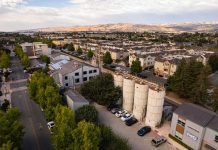The development of Coyote Valley (CV) is rapidly moving forward
and a specific plan is now taking shape to create a city of 25,000
housing units for a population of about 80,000 people and about
50,000 jobs over the next 10-20 years.
The development of Coyote Valley (CV) is rapidly moving forward and a specific plan is now taking shape to create a city of 25,000 housing units for a population of about 80,000 people and about 50,000 jobs over the next 10-20 years. A new city is in the process of being created on the border of San Jose with Morgan Hill. You may see all the details at the San Jose Web site at www.ci.sanjose.ca.us.coyotevalley.com. In case you’re not aware of it, Coyote Valley is within the jurisdiction of the Morgan Hill School District (even though located entirely within the City of San Jose). What’s going to happen now?
The Coyote Valley Specific Plan, with endorsement from the Greenbelt Alliance, calls for the construction of seven elementary schools, two middle schools and one (possibly two) high schools to accommodate the needs of educating the children of 80,000 residents. Their concept for these schools is very different than the criteria according to the state Education Code and the model that is being used by the Morgan Hill School District.
First, state standards call for 10 acres of land for elementary schools, 20 acres for middle schools and 40 acres for high schools. Thus, using state standards, there should be a minimum of 160-200 acres of land allocated for schools in Coyote Valley. The CV Task Force is planning to allocate only 100 acres for schools.
Second, there is an even larger problem regarding the numbers of schools that need to be built. Morgan Hill Unified currently serves a population of about 50,000 people in the City of Morgan Hill and including areas of San Martin, unincorporated areas of Santa Clara County and a small portion of south San Jose. To serve this population base with more than 8,600 students, the district operates nine elementary schools, one charter school, two middle schools, two high schools, a continuation high school and a home schooling program.
Is it reasonable to think that an additional 80,000 people in Coyote Valley can be served by building fewer schools than now serve 50,000 people? The Coyote Valley Task Force and the Green Belt Alliance think exactly that. Their vision for Coyote Valley is to change the state Board of Education code to allow for high rise-high density school buildings on smaller sites. The Green Belt Alliance has said in its publication, “A Vision For Coyote Valley – Getting It Right”, that “… given the urban character envisioned for Coyote Valley, urban acreage standards … are considered more appropriate than the state acreage standards normally used by the Morgan Hill District.” In other words, the Greenbelt Alliance says that smaller school sites are acceptable and the California Education Code will simply have to be changed to accommodate San Jose’s development plans for Coyote Valley.
Further, they say the model for a high school (and, presumably, the other schools) should be the urban high schools built in San Francisco in the 1920’s and 1930’s as a “high rise – high density building complex of enduring dignity …”. The planners for the City of San Jose and the CV Task Force have eagerly endorsed this “high density-low land use” school model, but some members of the Morgan Hill School Board are opposed to this concept.
Third, Coyote Valley will be in its own specific geographic region with different wants and needs compared to suburban and rural Morgan Hill/San Martin/Santa Clara County. The people living, working and going to school in Coyote Valley will be more closely aligned with metropolitan San Jose than with the suburbs of Morgan Hill.
Coyote Valley will consist of high density multi-story/multi-family living units in a very compact area as compared to Morgan Hill/San Martin with its predominately single family detached houses spread out over many square miles. The life style and living/working conditions will be completely different in Coyote Valley. With 80,000 residents there will be over 10,000 students in Coyote Valley, and that’s a large school district by any standard. With 80,000 residents in its own little valley, they deserve to have a school district of their own.
The time has come to seriously begin the process of letting Coyote Valley go its own way, to build its schools in the manner in which it feels is most appropriate for its high density urban character, to fund the construction of those schools and pay for their ongoing maintenance, operation and staffing. The time has come to form a new Coyote Valley School District.
Robert J. Benich is a Morgan Hill resident with a long record of civic involvement. Readers interested in writing a guest column should contact editor Walt Glines at ed******@*************es.com or 408-779-4106.







